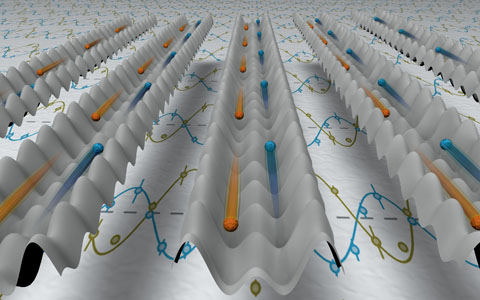9 July 2014
When a superconductor is exposed to a magnetic field, a current on its surface appears which creates a counter field that cancels the magnetic field inside the superconductor. This phenomenon, known as “Meissner-Ochsenfeld effect” after its discoverers, was first observed in 1933. This quantum effect has found applications in a large variety of fields, ranging from magnetic levitation of objects to medicine and industry. For the first time, scientists in the group of Professor Immanuel Bloch (Ludwig-Maximilians-University, Munich and Max Planck Institute of Quantum Optics, Garching) in collaboration with theoretical physicist Dr. Belén Paredes from the Institute for Theoretical Physics (IFT) in Madrid have succeeded in measuring an analogue of the Meissner effect in an optical crystal with ultracold atoms. The system realized by the team in fact constitutes the minimal system in which such a Meissner analogue can be observed and realizes theoretical predictions dating back more than 20 years. Furthermore, the scientists have been able to observe a transition from this Meissner phase to a vortex phase where the ‘screening’ of the external field breaks down. (Nature Physics, 2998 (2014)).
When a superconductor is cooled down below its critical temperature, which is typically on the order of a few tens of Kelvin, it undergoes a phase transition to a superconducting state. In that state, in addition to be able to transport electric currents without losses, the material presents a very special feature: when it is exposed to an external magnetic field, a current appears on its surface that fully cancels the field in its core. As the external field is increased, the strength of the current also increases. This feature, called Meissner effect, is of key importance in condensed matter physics. For some special types of superconductors this effect can only exist up to a critical strength of the external field. If the field is increased above that value, the current flows and spins around imaginary axis forming a vortex-like structure. In that vortex phase, the external field is only partially cancelled. These two behaviours have been already observed for real materials, and are of fundamental interest for the superconducting properties. “However, this kind of phenomenon had never been observed with ultracold atoms in optical crystals”, explains Marcos Atala, a scientist in the team of Professor Bloch.
In their experiments, an extremely cold gas of Rubidium atoms was loaded into an optical lattice: a periodic structure of bright and dark areas, created by the interference of counter-propagating laser beams. In this lattice structure, the atoms are held in either dark or bright spots, depending on the wavelength of the light, and therefore align themselves in a regular pattern. The resulting periodic structure of light resembles the geometry of simple solid state crystals where the atoms play the role of the electrons, making it an ideal model system to simulate condensed matter physics. In this case, the experimentalists chose a special lattice configuration, which creates an optical crystal with a ladder-like shape (see Fig. 1).
When the electrons in a material are exposed to a magnetic field, they feel the effect of the Lorentz force, which acts perpendicular to their direction of motion, causing them to move in circles. However, the atoms in the optical crystal are electrically neutral and they do not feel that force. The experimentalists overcome this difficulty by implementing a special laser configuration that simulates the effect of a magnetic field: they used a pair of lasers that give a momentum kick to the atoms when they move from the left to the right leg of the ladder, and give a kick in the opposite direction when they move from the right to the left leg. These kicking lasers simulate the effect of a magnetic field of several thousand Tesla, something that is practically impossible to achieve with real magnetic fields.
The ladder system that the experimentalists realized also presents a Meissner- and a vortex-like phase, with the only difference that the neutral current here does not produce a backaction and thereby a screening of the magnetic field. In order to see the transition between the two phases, the Munich researchers implemented a protocol to measure the current on the individual legs of the ladder. That current is maximal in the Meissner phase and has a vortex structure in the vortex phase. The measurement idea was to prepare the atoms in either the Meissner or the vortex phase and then to suddenly split the ladder into an array of isolated two-site systems, similar to when a flowing liquid is suddenly stop by an array of barriers. This method allowed the scientist to determine the strength of the current along the legs of the ladder, and they were able to clearly identify a transition from the vortex phase to the Meissner phase.
This experiment marks an important step forward in the simulation of real material properties using ultracold atoms in optical lattices, and opens the path to the observation of many other phenomena like the quantum Hall effect or even the fractional quantum Hall effect if interparticle interactions are present. Furthermore, by combining this technique with the new available single site resolution, experimentalist could resolve the vortex structure in the ladder locally. “The new experimental probes help us to gain a better understanding of phase transitions and dynamics of quantum matter under the action of extreme magnetic fields”, points out Prof. Immanuel Bloch.
Original publication:
Marcos Atala, Monika Aidelsburger, Michael Lohse, Julio T. Barreiro, Belén Paredes and Immanuel Bloch
Observation of chiral currents with ultracold atoms in bosonic ladders
Nature Physics, 2998 (2014), Advance Online Publication
Source:















